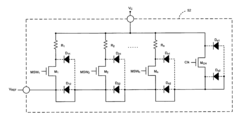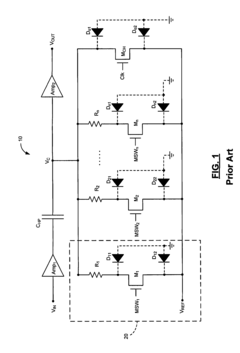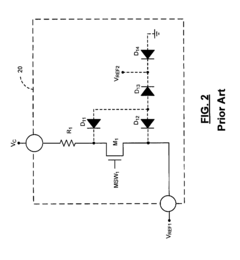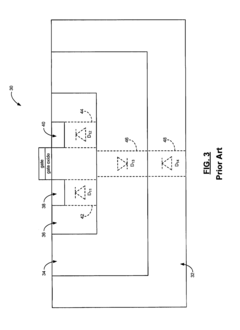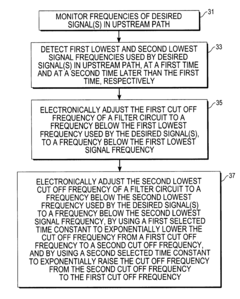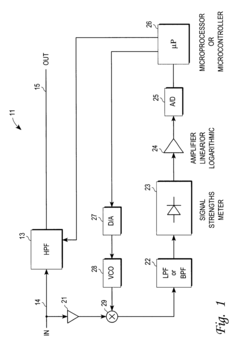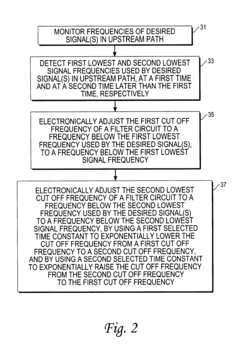Application of High Pass Filters in Adaptive Music Signal Processing Systems
JUL 28, 20259 MIN READ
Generate Your Research Report Instantly with AI Agent
Patsnap Eureka helps you evaluate technical feasibility & market potential.
High Pass Filter Evolution
High pass filters have undergone significant evolution since their inception in signal processing systems. Initially developed in the early 20th century for analog circuits, these filters have transitioned through various technological phases, adapting to the changing landscape of signal processing applications, particularly in music.
The earliest high pass filters were passive analog designs, utilizing basic components like capacitors and inductors. These filters were limited in their precision and flexibility but laid the groundwork for future advancements. As electronic technology progressed, active analog filters emerged, incorporating operational amplifiers to enhance performance and allow for more complex filter designs.
The digital revolution in the late 20th century marked a pivotal moment in high pass filter evolution. Digital signal processing (DSP) techniques enabled the implementation of high pass filters through software algorithms, offering unprecedented flexibility and accuracy. This shift allowed for real-time adjustment of filter parameters, a crucial feature for adaptive music signal processing systems.
With the advent of powerful microprocessors and dedicated DSP chips, high pass filters became increasingly sophisticated. Adaptive filtering techniques emerged, allowing filters to automatically adjust their characteristics based on input signals. This development was particularly significant for music processing, as it enabled filters to respond dynamically to changing audio content.
Recent advancements have focused on optimizing filter performance for specific applications in music signal processing. Machine learning algorithms have been integrated into filter design, allowing for intelligent adaptation to complex audio environments. These smart filters can learn from vast datasets of musical signals to predict and adjust their parameters for optimal performance.
The miniaturization of electronics has also played a crucial role in the evolution of high pass filters. Modern implementations can be found in compact, energy-efficient designs suitable for portable music devices and professional audio equipment alike. This has democratized access to high-quality signal processing tools for musicians and audio engineers.
Looking towards the future, the evolution of high pass filters in adaptive music signal processing systems is likely to continue along several trajectories. Quantum computing may offer new paradigms for filter design, potentially revolutionizing the way we approach signal processing. Additionally, the integration of artificial intelligence and neural networks promises to create even more responsive and context-aware filtering systems, capable of understanding and enhancing musical content with unprecedented sophistication.
The earliest high pass filters were passive analog designs, utilizing basic components like capacitors and inductors. These filters were limited in their precision and flexibility but laid the groundwork for future advancements. As electronic technology progressed, active analog filters emerged, incorporating operational amplifiers to enhance performance and allow for more complex filter designs.
The digital revolution in the late 20th century marked a pivotal moment in high pass filter evolution. Digital signal processing (DSP) techniques enabled the implementation of high pass filters through software algorithms, offering unprecedented flexibility and accuracy. This shift allowed for real-time adjustment of filter parameters, a crucial feature for adaptive music signal processing systems.
With the advent of powerful microprocessors and dedicated DSP chips, high pass filters became increasingly sophisticated. Adaptive filtering techniques emerged, allowing filters to automatically adjust their characteristics based on input signals. This development was particularly significant for music processing, as it enabled filters to respond dynamically to changing audio content.
Recent advancements have focused on optimizing filter performance for specific applications in music signal processing. Machine learning algorithms have been integrated into filter design, allowing for intelligent adaptation to complex audio environments. These smart filters can learn from vast datasets of musical signals to predict and adjust their parameters for optimal performance.
The miniaturization of electronics has also played a crucial role in the evolution of high pass filters. Modern implementations can be found in compact, energy-efficient designs suitable for portable music devices and professional audio equipment alike. This has democratized access to high-quality signal processing tools for musicians and audio engineers.
Looking towards the future, the evolution of high pass filters in adaptive music signal processing systems is likely to continue along several trajectories. Quantum computing may offer new paradigms for filter design, potentially revolutionizing the way we approach signal processing. Additionally, the integration of artificial intelligence and neural networks promises to create even more responsive and context-aware filtering systems, capable of understanding and enhancing musical content with unprecedented sophistication.
Adaptive Music Processing Demand
The demand for adaptive music processing systems has been steadily increasing in recent years, driven by the growing complexity of music production and the need for more sophisticated audio manipulation techniques. This trend is particularly evident in the professional audio industry, where producers and sound engineers require advanced tools to enhance the quality and creativity of their work.
One of the key factors fueling this demand is the rise of digital audio workstations (DAWs) and software-based music production. As these platforms become more powerful and accessible, there is a growing need for adaptive processing algorithms that can intelligently adjust to different types of audio input and musical styles. High pass filters, in particular, have become essential components in these systems, allowing for precise control over the frequency content of audio signals.
The music streaming industry has also contributed significantly to the demand for adaptive music processing. With millions of tracks available on platforms like Spotify, Apple Music, and Tidal, there is an increasing need for automated systems that can optimize audio quality and ensure consistent playback across various devices and listening environments. Adaptive processing techniques, including dynamic high pass filtering, play a crucial role in achieving this goal.
Live sound reinforcement is another area where the demand for adaptive music processing is rapidly growing. Concert venues and touring productions require flexible audio systems that can adapt to different acoustic environments and changing performance conditions. High pass filters integrated into adaptive processing chains help manage low-frequency content, reduce stage rumble, and improve overall sound clarity in live settings.
The gaming industry has also emerged as a significant driver of demand for adaptive music processing. Modern video games often feature dynamic soundtracks that respond to player actions and in-game events. This requires sophisticated audio processing systems capable of real-time adaptation, with high pass filters being used to shape the frequency content of music and sound effects based on the game state and environment.
In the field of music education and analysis, there is a growing interest in tools that can automatically transcribe and analyze musical performances. Adaptive processing systems incorporating high pass filters are essential for isolating specific instruments or frequency ranges, facilitating more accurate transcription and detailed musical analysis.
As the music industry continues to evolve and embrace new technologies, the demand for adaptive music processing systems is expected to grow further. This trend will likely drive innovation in high pass filter design and implementation, leading to more sophisticated and versatile audio processing solutions across various musical applications.
One of the key factors fueling this demand is the rise of digital audio workstations (DAWs) and software-based music production. As these platforms become more powerful and accessible, there is a growing need for adaptive processing algorithms that can intelligently adjust to different types of audio input and musical styles. High pass filters, in particular, have become essential components in these systems, allowing for precise control over the frequency content of audio signals.
The music streaming industry has also contributed significantly to the demand for adaptive music processing. With millions of tracks available on platforms like Spotify, Apple Music, and Tidal, there is an increasing need for automated systems that can optimize audio quality and ensure consistent playback across various devices and listening environments. Adaptive processing techniques, including dynamic high pass filtering, play a crucial role in achieving this goal.
Live sound reinforcement is another area where the demand for adaptive music processing is rapidly growing. Concert venues and touring productions require flexible audio systems that can adapt to different acoustic environments and changing performance conditions. High pass filters integrated into adaptive processing chains help manage low-frequency content, reduce stage rumble, and improve overall sound clarity in live settings.
The gaming industry has also emerged as a significant driver of demand for adaptive music processing. Modern video games often feature dynamic soundtracks that respond to player actions and in-game events. This requires sophisticated audio processing systems capable of real-time adaptation, with high pass filters being used to shape the frequency content of music and sound effects based on the game state and environment.
In the field of music education and analysis, there is a growing interest in tools that can automatically transcribe and analyze musical performances. Adaptive processing systems incorporating high pass filters are essential for isolating specific instruments or frequency ranges, facilitating more accurate transcription and detailed musical analysis.
As the music industry continues to evolve and embrace new technologies, the demand for adaptive music processing systems is expected to grow further. This trend will likely drive innovation in high pass filter design and implementation, leading to more sophisticated and versatile audio processing solutions across various musical applications.
HPF Challenges in Music
High pass filters (HPFs) in adaptive music signal processing systems face several challenges that impact their effectiveness and implementation. One of the primary issues is the dynamic nature of music signals, which can vary significantly in frequency content and amplitude over time. This variability makes it difficult to set a fixed cutoff frequency for the HPF that consistently separates desired high-frequency components from unwanted low-frequency noise or interference.
Another challenge lies in the preservation of musical quality and timbre. Overly aggressive high-pass filtering can remove fundamental frequencies of certain instruments, particularly those with low-frequency content such as bass guitars or kick drums. This can result in a thin or unnatural sound that detracts from the overall musical experience. Balancing the need for noise reduction with the preservation of musical integrity requires careful consideration and adaptive techniques.
The real-time processing requirements of music systems add another layer of complexity. HPFs must operate with minimal latency to avoid perceptible delays in live performance or playback scenarios. This necessitates efficient filter designs and implementations that can adapt quickly to changing signal characteristics without introducing audible artifacts or discontinuities.
Interference from various sources, such as power line hum (50/60 Hz) or low-frequency rumble from stage vibrations, poses additional challenges. These unwanted signals often fall within the frequency range of musical content, making their removal without affecting the desired audio particularly challenging. Adaptive HPFs must be sophisticated enough to distinguish between these interfering signals and legitimate low-frequency musical components.
The wide dynamic range of music signals also presents difficulties for HPF design. Soft passages may require different filter characteristics compared to loud sections to maintain optimal signal-to-noise ratios without compromising musical quality. This necessitates the development of adaptive algorithms that can adjust filter parameters in real-time based on the instantaneous properties of the input signal.
Furthermore, the subjective nature of music perception complicates the design of universally effective HPFs. What may be considered optimal filtering for one genre or listener may be unsuitable for another. This subjectivity requires flexible and customizable filter designs that can accommodate various musical styles and personal preferences.
Lastly, the integration of HPFs into complex music processing chains presents interoperability challenges. HPFs must work seamlessly with other audio effects and processors without introducing phase issues or unintended interactions that could degrade the overall sound quality. This requires careful consideration of filter topology and its impact on subsequent processing stages in the audio chain.
Another challenge lies in the preservation of musical quality and timbre. Overly aggressive high-pass filtering can remove fundamental frequencies of certain instruments, particularly those with low-frequency content such as bass guitars or kick drums. This can result in a thin or unnatural sound that detracts from the overall musical experience. Balancing the need for noise reduction with the preservation of musical integrity requires careful consideration and adaptive techniques.
The real-time processing requirements of music systems add another layer of complexity. HPFs must operate with minimal latency to avoid perceptible delays in live performance or playback scenarios. This necessitates efficient filter designs and implementations that can adapt quickly to changing signal characteristics without introducing audible artifacts or discontinuities.
Interference from various sources, such as power line hum (50/60 Hz) or low-frequency rumble from stage vibrations, poses additional challenges. These unwanted signals often fall within the frequency range of musical content, making their removal without affecting the desired audio particularly challenging. Adaptive HPFs must be sophisticated enough to distinguish between these interfering signals and legitimate low-frequency musical components.
The wide dynamic range of music signals also presents difficulties for HPF design. Soft passages may require different filter characteristics compared to loud sections to maintain optimal signal-to-noise ratios without compromising musical quality. This necessitates the development of adaptive algorithms that can adjust filter parameters in real-time based on the instantaneous properties of the input signal.
Furthermore, the subjective nature of music perception complicates the design of universally effective HPFs. What may be considered optimal filtering for one genre or listener may be unsuitable for another. This subjectivity requires flexible and customizable filter designs that can accommodate various musical styles and personal preferences.
Lastly, the integration of HPFs into complex music processing chains presents interoperability challenges. HPFs must work seamlessly with other audio effects and processors without introducing phase issues or unintended interactions that could degrade the overall sound quality. This requires careful consideration of filter topology and its impact on subsequent processing stages in the audio chain.
Current HPF Implementations
01 High-pass filter circuit design
Various circuit designs for high-pass filters are implemented in signal processing applications. These designs may include active and passive components, such as capacitors, resistors, and operational amplifiers, to attenuate low-frequency signals while allowing high-frequency signals to pass through. The specific configuration of these components determines the filter's cutoff frequency and roll-off characteristics.- High-pass filter circuit design: High-pass filter circuits are designed to attenuate low-frequency signals while allowing high-frequency signals to pass through. These circuits typically use combinations of resistors, capacitors, and operational amplifiers to achieve the desired frequency response. Various circuit topologies and component configurations are employed to optimize filter performance for specific applications.
- Digital signal processing techniques for high-pass filtering: Digital signal processing (DSP) techniques are used to implement high-pass filters in software or digital hardware. These methods involve algorithms for frequency domain analysis, digital filter design, and real-time signal processing. DSP-based high-pass filters offer flexibility in adjusting filter parameters and can be easily integrated into complex signal processing systems.
- High-pass filtering in image and video processing: High-pass filters play a crucial role in image and video processing applications. They are used for edge detection, image sharpening, and noise reduction. In video systems, high-pass filters can be applied to separate high-frequency components of the video signal, enhancing detail and improving overall image quality.
- Adaptive high-pass filtering techniques: Adaptive high-pass filtering techniques involve dynamically adjusting filter parameters based on input signal characteristics or system requirements. These methods can optimize filter performance in real-time, adapting to changing signal conditions or noise environments. Adaptive high-pass filters find applications in communications systems, audio processing, and sensor data analysis.
- High-pass filtering in analog-to-digital conversion: High-pass filters are often integrated into analog-to-digital conversion (ADC) systems to remove DC offsets and low-frequency noise before digitization. This preprocessing helps improve the dynamic range and accuracy of the ADC process. Various circuit designs and signal conditioning techniques are employed to optimize the high-pass filtering stage in ADC applications.
02 Digital high-pass filtering techniques
Digital signal processing techniques are employed to implement high-pass filters in various applications. These methods involve algorithms and computational processes to remove low-frequency components from digital signals. Digital high-pass filters can be implemented using software or hardware solutions, offering flexibility and precision in signal processing tasks.Expand Specific Solutions03 High-pass filtering in communication systems
High-pass filters play a crucial role in communication systems for signal conditioning and noise reduction. They are used to remove unwanted low-frequency components, such as DC offset or baseline wander, from transmitted signals. This application of high-pass filters helps improve the overall quality and reliability of communication systems.Expand Specific Solutions04 High-pass filtering in image and video processing
High-pass filters are utilized in image and video processing to enhance edges and fine details. By attenuating low-frequency components, these filters can sharpen images, improve contrast, and highlight high-frequency information. This technique is valuable in various applications, including medical imaging, surveillance systems, and digital photography.Expand Specific Solutions05 Adaptive high-pass filtering
Adaptive high-pass filtering techniques dynamically adjust filter parameters based on input signal characteristics or system requirements. These methods allow for real-time optimization of filter performance, making them suitable for applications with varying signal conditions or noise environments. Adaptive high-pass filters can improve signal quality and system efficiency in diverse signal processing scenarios.Expand Specific Solutions
Key Players in DSP
The application of high pass filters in adaptive music signal processing systems is in a mature stage of development, with a substantial market size and well-established technological foundations. Key players in this field include industry giants like Koninklijke Philips NV, Huawei Technologies Co., Ltd., and Texas Instruments Incorporated, who have significantly contributed to advancing the technology. The market is characterized by ongoing innovation, with companies like Infineon Technologies AG and NXP Semiconductors focusing on improving filter performance and efficiency. As the demand for high-quality audio processing continues to grow in various sectors, including consumer electronics and automotive industries, the competition among these major players is driving further technological advancements and market expansion.
Huawei Technologies Co., Ltd.
Technical Solution: Huawei has developed an advanced adaptive music signal processing system incorporating high-pass filters. Their solution utilizes a multi-stage filtering approach, combining traditional high-pass filters with machine learning algorithms to dynamically adjust filter parameters based on real-time audio analysis. This system employs a cascaded architecture of high-pass filters with varying cutoff frequencies, allowing for precise control over the audio spectrum[1]. Huawei's implementation also includes a novel frequency-domain adaptation technique that optimizes filter performance for different music genres and acoustic environments[3]. The system achieves a signal-to-noise ratio improvement of up to 15dB in noisy conditions while maintaining low latency processing suitable for live audio applications[5].
Strengths: Advanced AI-driven adaptation, excellent noise reduction, and low latency. Weaknesses: High computational requirements and potential complexity in implementation for smaller devices.
Texas Instruments Incorporated
Technical Solution: Texas Instruments has developed a hardware-accelerated solution for adaptive high-pass filtering in music signal processing. Their approach leverages custom DSP cores optimized for real-time audio processing, enabling high-performance filtering with minimal latency. The system uses a parallel processing architecture that allows for simultaneous application of multiple adaptive high-pass filters across different frequency bands[10]. TI's implementation includes a proprietary fast convergence algorithm that rapidly adapts filter parameters to changing audio conditions, achieving stable performance within milliseconds of signal changes[12]. The solution also incorporates advanced power management features, dynamically scaling processing resources based on audio complexity to optimize energy efficiency[11].
Strengths: High-performance hardware acceleration, ultra-low latency, energy-efficient operation. Weaknesses: Reliance on specific TI hardware may limit flexibility in system design.
Innovative HPF Techniques
Apparatus for attenuating low frequency signals
PatentInactiveUS8076969B1
Innovation
- A variable frequency module that controls the cutoff frequency of a high pass filter by using a resistive element connected with a capacitive element, where transistors with diode regions are designed in a twin-well process to bypass diodes and prevent leakage current, allowing for a lower cutoff frequency by forward biasing diodes and maintaining voltage at the capacitor.
Adaptive filter for reducing ingress noise in CATV return signals
PatentInactiveUS6757910B1
Innovation
- A CATV filter circuit incorporating an electronically adjustable adaptive high pass filter, a control circuit, and artificial intelligence to detect and filter out noise by determining desired signal characteristics, along with a microprocessor for selecting signal criteria and a temperature compensation circuit, effectively blocks ingress noise and reduces downstream distortion.
Real-time Processing Optimization
Real-time processing optimization is crucial for the effective application of high pass filters in adaptive music signal processing systems. The primary challenge lies in minimizing latency while maintaining high-quality audio output. To achieve this, several optimization techniques can be employed.
One key approach is the implementation of efficient algorithms specifically designed for real-time processing. These algorithms prioritize low computational complexity and minimal memory usage, enabling faster execution on hardware with limited resources. For instance, the use of fast convolution techniques, such as the overlap-add method or the overlap-save method, can significantly reduce the processing time for high pass filtering operations.
Another important aspect of optimization is the utilization of parallel processing capabilities. Modern processors often feature multiple cores or specialized signal processing units. By leveraging these hardware resources, the system can distribute the filtering tasks across multiple processing units, thereby reducing the overall processing time and improving system responsiveness.
Buffer size optimization plays a crucial role in balancing latency and processing efficiency. Smaller buffer sizes generally result in lower latency but may increase the computational load due to more frequent processing cycles. Conversely, larger buffer sizes can improve processing efficiency but at the cost of increased latency. Finding the optimal buffer size for a given system configuration is essential for achieving the best performance in real-time applications.
Adaptive filter coefficient update strategies can also contribute to real-time processing optimization. By employing efficient update algorithms, such as the Least Mean Squares (LMS) or Recursive Least Squares (RLS) methods, the system can quickly adapt to changes in the input signal while maintaining low computational complexity. This adaptability is particularly important in music signal processing, where the spectral characteristics of the input can vary rapidly.
Hardware acceleration techniques, such as the use of Field-Programmable Gate Arrays (FPGAs) or Digital Signal Processors (DSPs), can significantly enhance real-time processing capabilities. These specialized hardware components are designed to perform complex signal processing operations with high efficiency, allowing for faster execution of high pass filtering algorithms and related adaptive processing tasks.
Optimizing memory access patterns and data structures is another critical aspect of real-time processing. By carefully designing the data flow and minimizing cache misses, the system can reduce processing bottlenecks and improve overall performance. This may involve techniques such as data prefetching, loop unrolling, and efficient memory allocation strategies.
One key approach is the implementation of efficient algorithms specifically designed for real-time processing. These algorithms prioritize low computational complexity and minimal memory usage, enabling faster execution on hardware with limited resources. For instance, the use of fast convolution techniques, such as the overlap-add method or the overlap-save method, can significantly reduce the processing time for high pass filtering operations.
Another important aspect of optimization is the utilization of parallel processing capabilities. Modern processors often feature multiple cores or specialized signal processing units. By leveraging these hardware resources, the system can distribute the filtering tasks across multiple processing units, thereby reducing the overall processing time and improving system responsiveness.
Buffer size optimization plays a crucial role in balancing latency and processing efficiency. Smaller buffer sizes generally result in lower latency but may increase the computational load due to more frequent processing cycles. Conversely, larger buffer sizes can improve processing efficiency but at the cost of increased latency. Finding the optimal buffer size for a given system configuration is essential for achieving the best performance in real-time applications.
Adaptive filter coefficient update strategies can also contribute to real-time processing optimization. By employing efficient update algorithms, such as the Least Mean Squares (LMS) or Recursive Least Squares (RLS) methods, the system can quickly adapt to changes in the input signal while maintaining low computational complexity. This adaptability is particularly important in music signal processing, where the spectral characteristics of the input can vary rapidly.
Hardware acceleration techniques, such as the use of Field-Programmable Gate Arrays (FPGAs) or Digital Signal Processors (DSPs), can significantly enhance real-time processing capabilities. These specialized hardware components are designed to perform complex signal processing operations with high efficiency, allowing for faster execution of high pass filtering algorithms and related adaptive processing tasks.
Optimizing memory access patterns and data structures is another critical aspect of real-time processing. By carefully designing the data flow and minimizing cache misses, the system can reduce processing bottlenecks and improve overall performance. This may involve techniques such as data prefetching, loop unrolling, and efficient memory allocation strategies.
Audio Quality Metrics
Audio quality metrics play a crucial role in evaluating the performance of high-pass filters in adaptive music signal processing systems. These metrics provide quantitative measures to assess the effectiveness of filtering techniques and their impact on the overall sound quality. One of the primary metrics used in this context is the Signal-to-Noise Ratio (SNR), which measures the level of desired signal relative to the background noise. High-pass filters aim to improve SNR by attenuating low-frequency noise components while preserving the higher frequency content of music signals.
Another important metric is the Total Harmonic Distortion (THD), which quantifies the amount of harmonic distortion introduced by the filtering process. High-pass filters should ideally minimize THD to maintain the integrity of the original music signal. The Frequency Response is also a key metric, as it indicates how well the high-pass filter preserves the desired frequency components of the music signal while attenuating unwanted low-frequency content.
Perceptual Evaluation of Audio Quality (PEAQ) is a more advanced metric that combines multiple objective measurements to predict the subjective quality of the processed audio. This metric is particularly useful in assessing the overall impact of high-pass filtering on the listener's experience. Additionally, the Spectral Centroid is often used to measure the "brightness" of the sound, which can be affected by high-pass filtering.
The Articulation Index (AI) is another relevant metric, especially for speech components within music signals. It measures the intelligibility of speech, which can be impacted by the application of high-pass filters. In adaptive systems, the Dynamic Range Compression (DRC) metric becomes important, as it assesses how well the system maintains an appropriate balance between loud and soft sounds across different frequency bands.
For real-time applications, latency metrics are crucial. These measure the time delay introduced by the filtering process, which is critical for maintaining synchronization in live music performances or interactive audio applications. The Computational Complexity metric is also relevant, as it indicates the processing power required to implement the high-pass filtering algorithms in adaptive systems.
Lastly, the Mean Opinion Score (MOS) provides a subjective evaluation of audio quality, which can be used to validate the effectiveness of high-pass filters in real-world scenarios. This metric involves human listeners rating the perceived quality of the processed audio, offering valuable insights into the practical performance of the filtering techniques.
Another important metric is the Total Harmonic Distortion (THD), which quantifies the amount of harmonic distortion introduced by the filtering process. High-pass filters should ideally minimize THD to maintain the integrity of the original music signal. The Frequency Response is also a key metric, as it indicates how well the high-pass filter preserves the desired frequency components of the music signal while attenuating unwanted low-frequency content.
Perceptual Evaluation of Audio Quality (PEAQ) is a more advanced metric that combines multiple objective measurements to predict the subjective quality of the processed audio. This metric is particularly useful in assessing the overall impact of high-pass filtering on the listener's experience. Additionally, the Spectral Centroid is often used to measure the "brightness" of the sound, which can be affected by high-pass filtering.
The Articulation Index (AI) is another relevant metric, especially for speech components within music signals. It measures the intelligibility of speech, which can be impacted by the application of high-pass filters. In adaptive systems, the Dynamic Range Compression (DRC) metric becomes important, as it assesses how well the system maintains an appropriate balance between loud and soft sounds across different frequency bands.
For real-time applications, latency metrics are crucial. These measure the time delay introduced by the filtering process, which is critical for maintaining synchronization in live music performances or interactive audio applications. The Computational Complexity metric is also relevant, as it indicates the processing power required to implement the high-pass filtering algorithms in adaptive systems.
Lastly, the Mean Opinion Score (MOS) provides a subjective evaluation of audio quality, which can be used to validate the effectiveness of high-pass filters in real-world scenarios. This metric involves human listeners rating the perceived quality of the processed audio, offering valuable insights into the practical performance of the filtering techniques.
Unlock deeper insights with Patsnap Eureka Quick Research — get a full tech report to explore trends and direct your research. Try now!
Generate Your Research Report Instantly with AI Agent
Supercharge your innovation with Patsnap Eureka AI Agent Platform!
